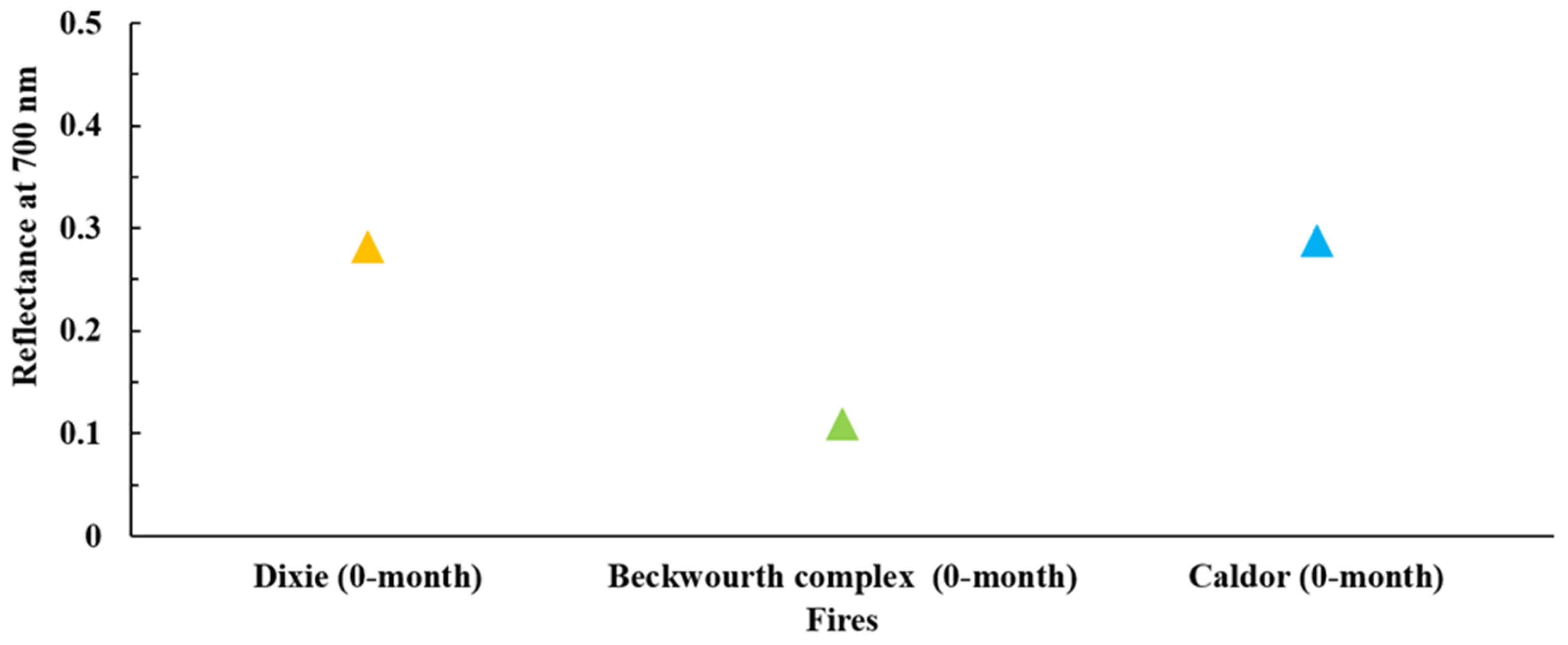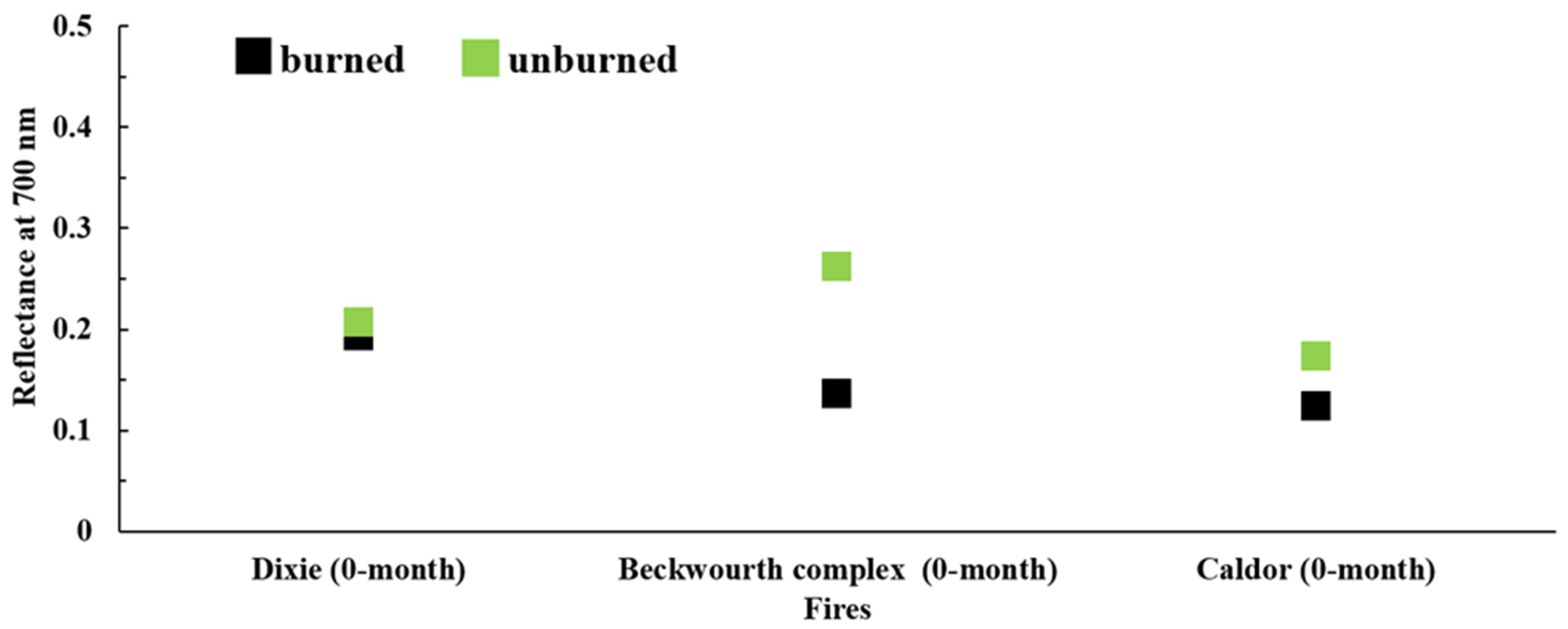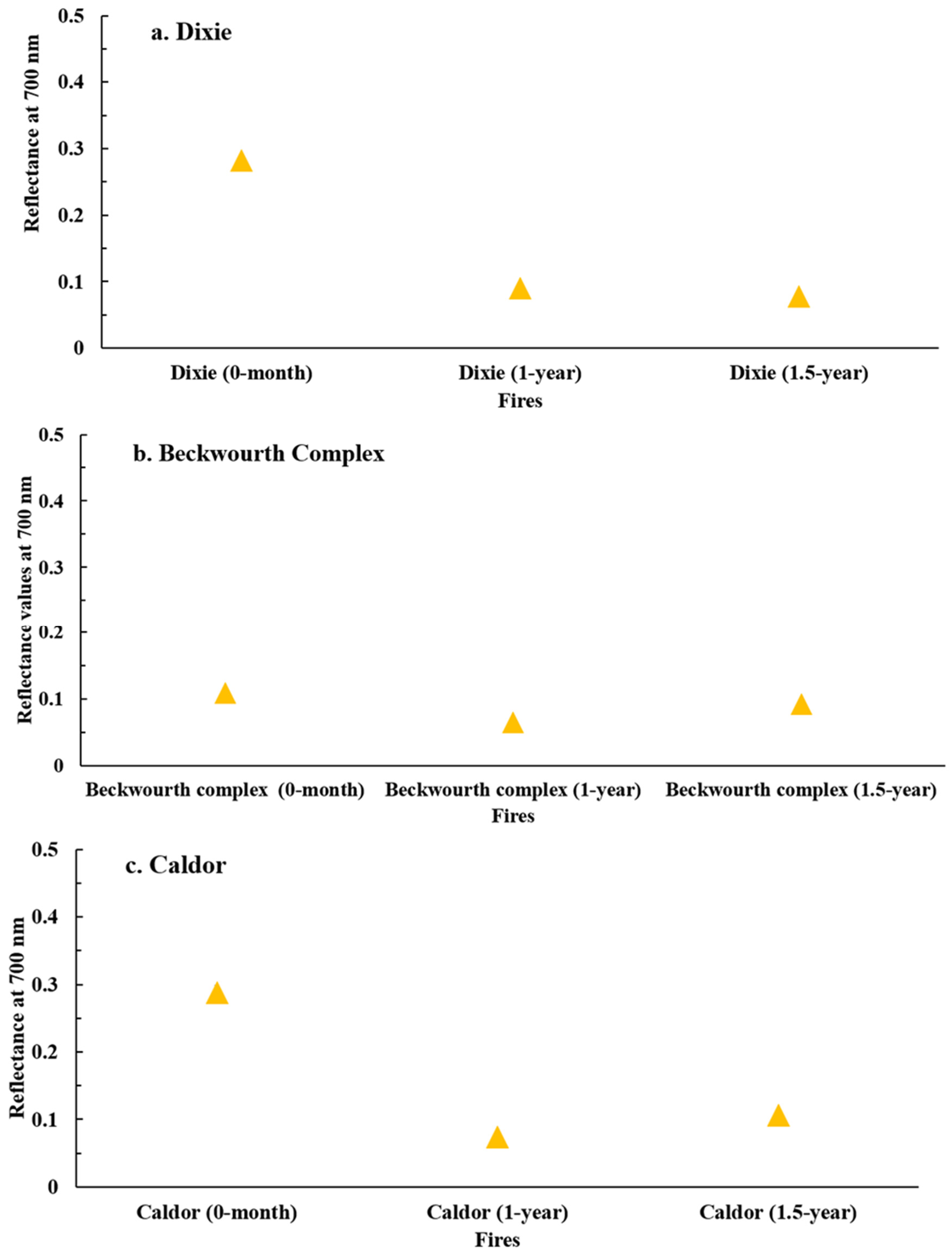Hyperspectral Reflectance and Chemical Composition of Pre- and Post-Fire Soils from Three 2021 Western USA Megafires
Abstract
:1. Introduction
2. Materials and Methods
2.1. Sampling
2.2. Spectral Measurements
2.3. FTIR Measurements
3. Results and Discussion
3.1. Reflectance Analysis of 0-Month Samples
3.2. Temporal Analysis of Reflectance after the Fire
3.3. FTIR Characterization of Ash Samples
4. Conclusions
Supplementary Materials
Author Contributions
Funding
Institutional Review Board Statement
Informed Consent Statement
Data Availability Statement
Acknowledgments
Conflicts of Interest
References
- Radeloff, V.C.; Helmers, D.P.; Kramer, H.A.; Mockrin, M.H.; Alexandre, P.M.; Bar-Massada, A.; Butsic, V.; Hawbaker, T.J.; Martinuzzi, S.; Syphard, A.D.; et al. Rapid growth of the US wildland-urban interface raises wildfire risk. Proc. Natl. Acad. Sci. USA 2018, 115, 3314–3319. [Google Scholar] [CrossRef] [PubMed]
- Arkle, R.S.; Pilliod, D.S. Prescribed fires as ecological surrogates for wildfires: A stream and riparian perspective. For. Ecol. Manag. 2010, 259, 893–903. [Google Scholar] [CrossRef]
- Samburova, V.; Schneider, E.; Rüger, C.P.; Inouye, S.; Sion, B.; Axelrod, K.; Bahdanovich, P.; Friederici, L.; Raeofy, Y.; Berli, M.; et al. Modification of Soil Hydroscopic and Chemical Properties Caused by Four Recent California, USA Megafires. Fire 2023, 6, 186. [Google Scholar] [CrossRef]
- McClure, C.D.; Jaffe, D.A. US particulate matter air quality improves except in wildfire-prone areas. Proc. Natl. Acad. Sci. USA 2018, 115, 7901–7906. [Google Scholar] [CrossRef] [PubMed]
- Steel, Z.L.; Safford, H.D.; Viers, J.H. The fire frequency-severity relationship and the legacy of fire suppression in California forests. Ecosphere 2015, 6, 23. [Google Scholar] [CrossRef]
- Keeley, J.E.; Syphard, A.D. Large California wildfires: 2020 fires in historical context. Fire Ecol. 2021, 17, 11. [Google Scholar] [CrossRef]
- CalFire. Available online: https://www.fire.ca.gov/incidents (accessed on 27 October 2023).
- Letey, J. Causes and consequences of fire-induced soil water repellency. Hydrol. Process. 2001, 15, 2867–2875. [Google Scholar] [CrossRef]
- Fernandez-Marcos, M.L. Potentially Toxic Substances and Associated Risks in Soils Affected by Wildfires: A Review. Toxics 2022, 10, 31. [Google Scholar] [CrossRef]
- Lobell, D.B.; Asner, G.P. Moisture effects on soil reflectance. Soil Sci. Soc. Am. J. 2002, 66, 722–727. [Google Scholar] [CrossRef]
- Jordán, A.; Zavala, L.M.; Granged, A.J.P.; Gordillo-Rivero, Á.J.; García-Moreno, J.; Pereira, P.; Bárcenas-Moreno, G.; de Celis, R.; Jiménez-Compán, E.; Alanís, N. Wettability of ash conditions splash erosion and runoff rates in the post-fire. Sci. Total Environ. 2016, 572, 1261–1268. [Google Scholar] [CrossRef]
- Doerr, S.H.; Woods, S.W.; Martin, D.A.; Casimiro, M. ‘Natural background’ soil water repellency in conifer forests of the north-western USA: Its prediction and relationship to wildfire occurrence. J. Hydrol. 2009, 371, 12–21. [Google Scholar] [CrossRef]
- Wu, Y.C.; Zhang, N.; Slater, G.; Waddington, J.M.; de Lannoy, C.F. Hydrophobicity of peat soils: Characterization of organic compound changes associated with heat-induced water repellency. Sci. Total Environ. 2020, 714, 15. [Google Scholar] [CrossRef] [PubMed]
- Doerr, S.H.; Shakesby, R.A.; Walsh, R.P.D. Soil water repellency: Its causes, characteristics and hydro-geomorphological significance. Earth Sci. Rev. 2000, 51, 33–65. [Google Scholar] [CrossRef]
- DeBano, L.F. Water Repellent Soils: A State-of-the-Art; US Department of Agriculture, Forest Service, Pacific Southwest Forest and Range Experiment Station: Washington, DC, USA, 1981; Volume 46. [Google Scholar]
- DeBano, L.F.; Krammes, J. Water repellent soils and their relation to wildfire temperatures. Hydrol. Sci. J. 1966, 11, 14–19. [Google Scholar] [CrossRef]
- Samburova, V.; Shillito, R.M.; Berli, M.; Khlystov, A.Y.; Moosmuller, H. Effect of Biomass-Burning Emissions on Soil Water Repellency: A Pilot Laboratory Study. Fire 2021, 4, 24. [Google Scholar] [CrossRef]
- Atanassova, I.; Doerr, S.H. Changes in soil organic compound composition associated with heat-induced increases in soil water repellency. Eur. J. Soil Sci. 2011, 62, 516–532. [Google Scholar] [CrossRef]
- Chen, J.J.; Pangle, L.A.; Gannon, J.P.; Stewart, R.D. Soil water repellency after wildfires in the Blue Ridge Mountains, United States. Int. J. Wildland Fire 2020, 29, 1009–1020. [Google Scholar] [CrossRef]
- Sion, B.; Samburova, V.; Berli, M.; Baish, C.; Bustarde, J.; Houseman, S. Assessment of the Effects of the 2021 Caldor Megafire on Soil Physical Properties, Eastern Sierra Nevada, USA. Fire 2023, 6, 66. [Google Scholar] [CrossRef]
- Viscarra Rossel, R.A.; Walvoort, D.J.J.; McBratney, A.B.; Janik, L.J.; Skjemstad, J.O. Visible, near infrared, mid infrared or combined diffuse reflectance spectroscopy for simultaneous assessment of various soil properties. Geoderma 2006, 131, 59–75. [Google Scholar] [CrossRef]
- Yu, H.; Kong, B.; Wang, Q.; Liu, X.; Liu, X. Hyperspectral remote sensing applications in soil: A review. In Hyperspectral Remote Sensing; Elsevier: Amsterdam, The Netherlands, 2020; pp. 269–291. [Google Scholar]
- Rosero-Vlasova, O.A.; Perez-Cabello, F.; Lloveria, R.M.; Vlassova, L. Assessment of laboratory VIS-NIR-SWIR setups with different spectroscopy accessories for characterisation of soils from wildfire burns. Biosyst. Eng. 2016, 152, 51–67. [Google Scholar] [CrossRef]
- Finley, C.D. Field Evaluation and Hyperspectral Imagery Analysis of Fire-induced Water-Repellent Soils and Burn Severity in Southern Idaho Rangelands. Ph.D. Thesis, Idaho State University, Pocatello, ID, USA, 2006. [Google Scholar]
- Sestak, I.; Pereira, P.; Telak, L.J.; Percin, A.; Hrelja, I.; Bogunovic, I. Soil Chemical Properties and Fire Severity Assessment Using VNIR Proximal Spectroscopy in Fire-Affected Abandoned Orchard of Mediterranean Croatia. Agronomy 2022, 12, 129. [Google Scholar] [CrossRef]
- Vetrita, Y.; Santoso, I.; Kartika, T.; Prasasti, I. Indonesian savanna fire-related spectral analysis. In IOP Conference Series, Earth and Environmental Science; IOP Publishing: Bristol, UK, 2022; Volume 1109, p. 012076. [Google Scholar] [CrossRef]
- Finn, M.P.; Lewis, M.; Bosch, D.D.; Giraldo, M.; Yamamoto, K.; Sullivan, D.G.; Kincaid, R. Remote Sensing of Soil Moisture Using Airborne Hyperspectral Data. Gisci. Remote Sens. 2011, 48, 522–540. [Google Scholar] [CrossRef]
- Tatzber, M.; Stemmer, M.; Spiegel, H.; Katzlberger, C.; Haberhauer, G.; Gerzabek, M.H. alternative method to measure carbonate in soils by FT-IR spectroscopy. Environ. Chem. Lett. 2007, 5, 9–12. [Google Scholar] [CrossRef]
- Bruckman, V.J.; Wriessnig, K. Improved soil carbonate determination by FT-IR and X-ray analysis. Environ. Chem. Lett. 2013, 11, 65–70. [Google Scholar] [CrossRef] [PubMed]
- Dlapa, P.; BodÍ, M.B.; Mataix-Solera, J.; CerdÀ, A.; Doerr, S.H. FT-IR spectroscopy reveals that ash water repellency is highly dependent on ash chemical composition: Soil water repellency. Catena 2013, 108, 35–43. [Google Scholar] [CrossRef]
- Bodi, M.B.; Martin, D.A.; Balfour, V.N.; Santin, C.; Doerr, S.H.; Pereira, P.; Cerda, A.; Mataix-Solera, J. Wildland fire ash; production, composition and eco-hydro-geomorphic effects. Earth Sci. Rev. 2014, 130, 103–127. [Google Scholar] [CrossRef]
- Alayet, F.; Nouha, M.; Abdelaziz, S.; Saadi, A. Continuum removed band depth analysis for carbonate mining waste quantification using X-ray diffraction and hyperspectral spectroscopy in the north of Tunisia. J. Appl. Remote Sens. 2017, 11, 016021. [Google Scholar] [CrossRef]
- Sadrian, M.R.; Calvin, W.M.; Engelbrecht, J.P.; Moosmüller, H. Spectral Characterization of Parent Soils From Globally Important Dust Aerosol Entrainment Regions. J. Geophys. Res. Atmos. 2023, 128, e2022JD037666. [Google Scholar] [CrossRef]
- Ben-Dor, E.; Chabrillat, S.; Dematte, J.A.M.; Taylor, G.R.; Hill, J.; Whiting, M.L.; Sommer, S. Using Imaging Spectroscopy to study soil properties. Remote Sens. Environ. 2009, 113, S38–S55. [Google Scholar] [CrossRef]
- De la Rosa, J.M.; Merino, A.n.; Jiménez Morillo, N.T.; Jiménez-González, M.A.; González-Pérez, J.A.; González-Vila, F.J.; Knicker, H.; Almendros, G. Unveiling the effects of fire on soil organic matter by spectroscopic and thermal degradation methods. In Fire Effects in Soil Properties; CSIRO Publishing: Clayton, Australia, 2018; pp. 281–307. [Google Scholar]
- Simkovic, I.; Dlapa, P.; Doerr, S.H.; Mataix-Solera, J.; Sasinkova, V. Thermal destruction of soil water repellency and associated changes to soil organic matter as observed by FTIR spectroscopy. Catena 2008, 74, 205–211. [Google Scholar] [CrossRef]
- Mastrolonardo, G.; Francioso, O.; Di Foggia, M.; Bonora, S.; Rumpel, C.; Certini, G. Application of thermal and spectroscopic techniques to assess fire-induced changes to soil organic matter in a Mediterranean forest. J. Geochem. Explor. 2014, 143, 174–182. [Google Scholar] [CrossRef]
- Margenot, A.J.; Calderón, F.J.; Goyne, K.W.; Dmukome, F.N.; Parikh, S.J. IR spectroscopy, soil analysis applications. In Encyclopedia of Spectroscopy and Spectrometry; Elsevier: Amsterdam, The Netherlands, 2016; pp. 448–454. [Google Scholar]
- Brown, P.T.; Hanley, H.; Mahesh, A.; Reed, C.; Strenfel, S.J.; Davis, S.J.; Kochanski, A.K.; Clements, C.B. Climate warming increases extreme daily wildfire growth risk in California. Nature 2023, 621, 760–766. [Google Scholar] [CrossRef] [PubMed]
- Roy, D.P.; Boschetti, L.; Maier, S.W.; Smith, A.M.S. Field estimation of ash and char colour-lightness using a standard grey scale. Int. J. Wildland Fire 2010, 19, 698–704. [Google Scholar] [CrossRef]
- Laes, D.; Maus, P.; Lewis, S.; Robichaud, P.; Kokaly, R. Postfire Burn-Severity Classification of the Hayman Fire, CO: Based on Hyperspectral Data—JFSP RFP 2001-2 Task. 2004. Available online: https://forest.moscowfsl.wsu.edu/engr/library/Robichaud/Robichaud2004p/2004p.pdf (accessed on 27 October 2023).







| Fire Name | Start Date– End Date | Burned Area (km2) | Sample Type | Sampling Dates | Method Used for Analysis | GPS Coordinates of Sampling Sites |
|---|---|---|---|---|---|---|
| Dixie | 13 July 2021–25 October 2021 | 3898 | Ash, burned and unburned soil | 5 October 2021 30 October 2022 20 June 2023 | ASD FieldSpec3 FTIR * | 39°58′41.9″ N 120°21′24.8″ W |
| Beckwourth Complex | 4 July 2021–22 September 2021 | 428 | Ash, burned and unburned soil | 5 October 2021 30 October 2022 20 June 2023 | ASD FieldSpec3 | 39°53′21.1″ N 120°12′02.9″ W |
| Caldor | 14 August 2021–21 October 2021 | 898 | Ash, burned and unburned soil | 21 October 2021 19 November 2022 12 July 2023 | ASD FieldSpec3 | 38°50′37.0″ N 120°01′59.8″ W |
Disclaimer/Publisher’s Note: The statements, opinions and data contained in all publications are solely those of the individual author(s) and contributor(s) and not of MDPI and/or the editor(s). MDPI and/or the editor(s) disclaim responsibility for any injury to people or property resulting from any ideas, methods, instructions or products referred to in the content. |
© 2023 by the authors. Licensee MDPI, Basel, Switzerland. This article is an open access article distributed under the terms and conditions of the Creative Commons Attribution (CC BY) license (https://creativecommons.org/licenses/by/4.0/).
Share and Cite
Raeofy, Y.; Samburova, V.; Berli, M.; Sion, B.; Moosmüller, H. Hyperspectral Reflectance and Chemical Composition of Pre- and Post-Fire Soils from Three 2021 Western USA Megafires. Fire 2023, 6, 471. https://doi.org/10.3390/fire6120471
Raeofy Y, Samburova V, Berli M, Sion B, Moosmüller H. Hyperspectral Reflectance and Chemical Composition of Pre- and Post-Fire Soils from Three 2021 Western USA Megafires. Fire. 2023; 6(12):471. https://doi.org/10.3390/fire6120471
Chicago/Turabian StyleRaeofy, Yasaman, Vera Samburova, Markus Berli, Brad Sion, and Hans Moosmüller. 2023. "Hyperspectral Reflectance and Chemical Composition of Pre- and Post-Fire Soils from Three 2021 Western USA Megafires" Fire 6, no. 12: 471. https://doi.org/10.3390/fire6120471
APA StyleRaeofy, Y., Samburova, V., Berli, M., Sion, B., & Moosmüller, H. (2023). Hyperspectral Reflectance and Chemical Composition of Pre- and Post-Fire Soils from Three 2021 Western USA Megafires. Fire, 6(12), 471. https://doi.org/10.3390/fire6120471








